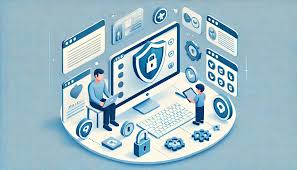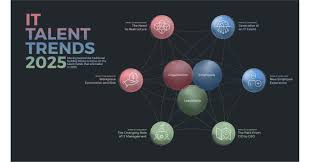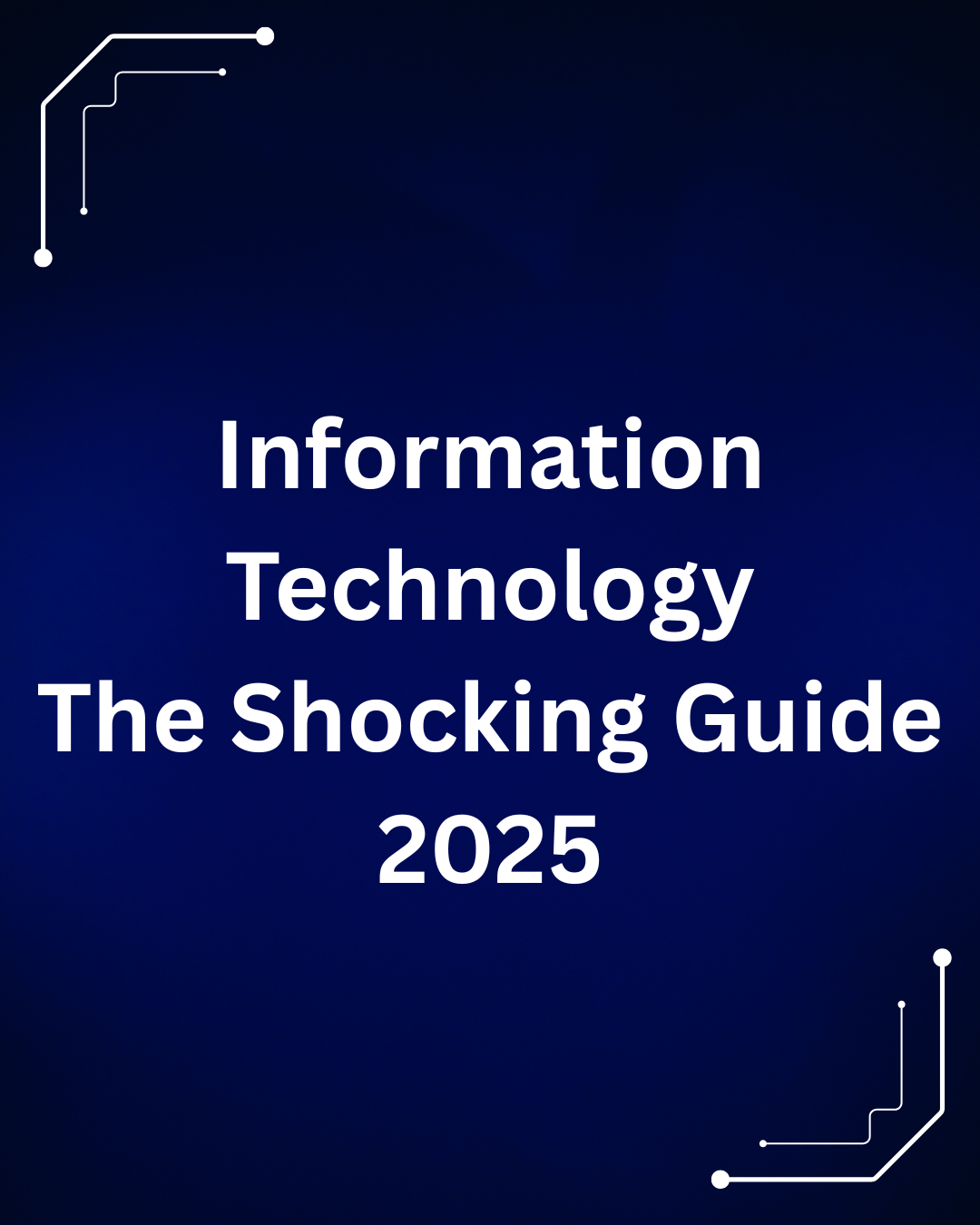Information Technology
Have you ever found yourself wondering, “How does all this stuff just… work?” while you were in the middle of scrolling through your phone? Imagine this: In 2025, your smart fridge reminds you to buy milk, your fitness tracker reminds you to take those extra steps, and your video chatting with a friend on the other side of the world. What’s behind these commonplace miracles? The unsung hero of our digital age is IT for short.
Although it’s part of the fun, IT is more than just fixing computers and coding late at night. Everything from international economies to your Netflix binge sessions is powered by this enormous ecosystem. Did you know that by 2025, the IT sector is expected to be worth an incredible $5.8 trillion?
That exceeds the GDP of the majority of nations! However, IT isn’t just for tech geeks wearing sweatshirts; it’s for everyone, from kids playing with apps to grandparents video-calling their grandchildren.
We’ll break down IT in this guide in a straightforward, interesting, and yes, slightly humorous manner. Consider it your neighborhood tour guide to the world of bits, bytes, and innovations. We’ll go over the fundamentals, history, and current trends, as well as how to get started yourself, whether you’re an inquisitive teenager, a thirtysomething career changer, or a retiree looking to take up new interests. Hold on tight—it’s time to unravel the mysteries of IT and discover why it is essential to contemporary living.
What Is Information Technology?
The Swiss Army knife of the digital world is IT, or IT for short. Fundamentally, it involves storing, retrieving, transmitting, and safeguarding information through the use of computers, software, networks, and procedures. To avoid becoming overly technical, think of IT as the unseen wizard that ensures your emails are sent, your photos are uploaded, and your online shopping cart doesn’t disappear.
IT, to put it simply, fills the gap between unprocessed data and insightful knowledge. It’s what allows doctors to quickly analyze MRI scans or transform a random collection of numbers into a customized Spotify playlist. We would still be communicating with carrier pigeons if it weren’t for IT—well, maybe not, but you get the idea.
Core Components of IT
Breaking down IT into its main parts makes it less intimidating. Here’s a quick rundown:
- Hardware: The physical stuff, like your laptop, servers, or that router blinking in your living room. Without hardware, IT would be all talk and no action.
- Software: The brains of the operation—programs and apps that tell hardware what to do. From operating systems like Windows to fun tools like photo editors, software is where the magic happens.
- Networks: The highways connecting everything. Think Wi-Fi, the internet, or even Bluetooth. Information technology relies on these to share data seamlessly.
- Databases: Where information lives. These organized storage systems ensure you can find that old email from 2015 without losing your mind.
And don’t forget people—IT pros who manage it all. IT isn’t just tech; it’s a human endeavor too.
IT vs. Computer Science
Ah, the age-old confusion: Are computer science and IT the same thing? Not quite! Information technology is the kitchen crew that prepares and serves the new recipes (algorithms, theories) that computer science is the theoretical chef creating (applying those ideas in real-world systems).
To secure your bank’s app, for example, an IT specialist might implement a new encryption technique that a computer scientist designed. While both are important, information technology is more concerned with real-world applications and user requirements.
For more information, see our guide to computer science fundamentals if you’re considering a career.
Evolution of Information Technology
Information technology did not become popular like a meme overnight. From basic abacuses to quantum computers, its origins can be traced back hundreds of years. Who knew punch cards could be so funny? Let’s take a humorous look back at its history.
Charles Babbage’s Analytical Engine, the forerunner of contemporary computers, was the catalyst for it all in the 19th century. The first electronic computer, the ENIAC, arrives on the scene in the 1940s, consuming electricity like a thirsty camel and weighing more than an elephant.
Thanks to innovators like Apple and Microsoft, personal computers became available in the 1970s. The digital revolution began when information technology was suddenly used in homes rather than just in labs.

From Punch Cards to AI
Do you recall punch cards? Those rigid paper artifacts that required a fresh start after a single incorrect hole? In the early days of information technology, they were the original data entry method. Floppy disks, CDs, USBs, and now cloud storage—where your files are accessible from anywhere—took over by the 1980s.
Information technology was accelerated with the advent of the internet in the 1990s. The World Wide Web, created by Tim Berners-Lee, transformed remote computers into a global community. Letters were replaced by email, and knowledge became instantaneous thanks to search engines like Google.
Information technology is smarter than ever thanks to the latest developments in artificial intelligence and machine learning. Who would have guessed that the voice assistant on your phone began with those awkward punch cards?
Key Milestones in IT
Let’s tabulate some pivotal moments in information technology for clarity:
| Year | Milestone | Impact on Information Technology |
|---|---|---|
| 1946 | ENIAC unveiled | First general-purpose electronic computer |
| 1969 | ARPANET (internet precursor) | Enabled data sharing between computers |
| 1981 | IBM PC launched | Made personal computing affordable |
| 1991 | World Wide Web goes public | Revolutionized information access |
| 2007 | iPhone debut | Ushered in mobile information technology |
| 2020s | AI boom with ChatGPT | Integrated intelligence into everyday IT |
This table shows how information technology has accelerated, turning sci-fi into reality.
Why Information Technology Matters Today
Information technology is as ubiquitous as air in 2025, but much more advanced. It connects people, drives economies, and finds solutions to issues we were unaware we had. Businesses wouldn’t function at all without IT, and your social media presence would be… nonexistent. Shudder.
But why is it so important? Innovation, effectiveness, and accessibility are all fueled by information technology. It’s the reason telemedicine allows you to see a doctor from the comfort of your couch and why remote work exploded during the pandemic.
IT in Everyday Life
Imagine your day: waking up to a smart alarm (IT at work), using your phone to check the weather (data networks), and listening to music on the cloud (cloud computing). Life is made easier and more enjoyable by information technology.
IT means educational games for children, online banking for adults, and family video calls for seniors. It bridges generations and is inclusive.
Are you curious about smart homes? Check out our overview of smart home technology.
Business Boost from IT
Information technology is revolutionary for businesses. It promotes growth, analyzes consumer data, and streamlines operations. IT-driven logistics and recommendations are the lifeblood of e-commerce behemoths like Amazon.
IT is used by small businesses for inventory management software and social media marketing. Reduced headaches and increased productivity are the outcomes.
Careers in Information Technology
Do you want to work solving puzzles and earning a good living? That and more are provided by information technology. IT jobs are in high demand, with a 15% growth predicted by 2030.
There is a position for every skill level, from C-suite CIOs to entry-level help desk positions. What’s the best part? You can code while you’re in your pajamas because many jobs allow remote work.
Top IT Job Roles
Here’s a bulleted list of popular careers in information technology:
- Software Developer: Builds apps and programs. Average salary: $120,000+.
- Network Administrator: Keeps connections running smoothly. Think Wi-Fi whisperer.
- Cybersecurity Analyst: Protects data from hackers. The digital bodyguard.
- Data Scientist: Turns data into insights. Like a fortune teller with spreadsheets.
- IT Project Manager: Oversees tech projects. The conductor of the IT orchestra.
Explore our career switcher tips for more.
Skills for IT Success
To thrive in information technology, hone these skills:
- Problem-solving: Fixing bugs is half the fun.
- Communication: Explaining tech to non-techies without jargon.
- Adaptability: IT evolves faster than fashion trends.
Certifications like CompTIA A+ or Cisco CCNA can kickstart your journey.
Future Trends in Information Technology
Peering into the crystal ball of information technology reveals exciting stuff. By 2030, IT will integrate even deeper into life, with AI, quantum computing, and 6G networks leading the charge.
Humor alert: Soon, your toaster might predict your breakfast mood—thanks to IT advancements!
Rise of Artificial Intelligence
AI is transforming information technology from reactive to predictive. Chatbots handle customer service, while machine learning optimizes everything from traffic lights to stock trades.
But remember, AI needs ethical oversight to avoid sci-fi dystopias.
Cloud Computing Revolution
Gone are local servers; hello, cloud! Information technology via platforms like AWS lets businesses scale without massive upfront costs. It’s flexible, secure, and eco-friendlier.
Internal link: Cloud basics for beginners.
Cybersecurity Challenges
With great IT power comes great responsibility—especially against cyber threats. Ransomware and phishing are rising, so information technology pros must stay vigilant.

Challenges Facing Information Technology
Information technology isn’t all rainbows and gigabytes. It faces hurdles like rapid obsolescence and ethical dilemmas.
For instance, e-waste from outdated hardware is a growing environmental issue. And let’s not forget the digital divide— not everyone has access to high-speed IT.
Data Privacy Concerns
In the age of big data, protecting personal info is paramount. Laws like GDPR help, but breaches still happen. Information technology must prioritize privacy to build trust.
Skills Gap in IT
There’s a shortage of qualified IT talent. Bridging this requires education and upskilling programs.
Check our IT training resources.
Read more: Top 15 New Technology Trends That Will Shock the World …
How to Dive into Information Technology
Ready to geek out? Starting in information technology is easier than you think. No PhD required—just curiosity and practice.
Begin with free online courses, tinker with code, or join tech communities.
Learning Resources for Beginners
- Codecademy or Khan Academy for coding basics.
- YouTube channels like freeCodeCamp.
- Books like “Clean Code” for deeper insights.
Building Your IT Toolkit
Assemble essentials: A reliable computer, software like Python, and a mindset for lifelong learning. Information technology rewards the persistent.
Read more: What Will Information Technology LOOK LIKE in 2025?
Conclusion
As we conclude our fast-paced exploration of information technology, we have witnessed its transformation from cumbersome devices to elegant artificial intelligence marvels, enabling everything from everyday conversations to multinational corporations. Whether you’re coding your first app or simply enjoying the technology behind your favorite device, it’s inclusive, creative, and offers a wealth of opportunities for people of all ages.
However, keep in mind that information technology is a dynamic, ever-evolving field that is always changing and expanding. Accept it, maintain your curiosity, and who knows? You could be the next great inventor.
Post your opinions in the comments section! Which IT device is your favorite, or do you have a question about how to get started? Together, let’s geek out by sharing below.
Read more: Nano Technology Ultimate Guide: Best in 2025
FAQs
What is information technology?
Information technology refers to using computers, networks, and software to manage and process data. Examples include email systems, databases, and cybersecurity tools. It’s essential for modern communication and business, evolving rapidly with trends like AI. Whether you’re a student or professional, understanding IT basics can enhance daily life and career prospects.
What are examples of information technology?
Common examples of information technology include smartphones for communication, cloud storage like Google Drive for data management, and antivirus software for security. Others are GPS navigation systems, e-commerce platforms like Amazon, and social media apps. These tools make life efficient, connecting people and automating tasks across industries.
What is the difference between IT and computer science?
Information technology focuses on applying tech solutions to business needs, like network management and user support. Computer science emphasizes theory, algorithms, and programming innovation. IT is more practical and user-oriented, while CS drives new tech creations. Both fields overlap but cater to different career paths.
Is information technology a good career?
Yes, information technology offers strong job growth, high salaries (often $80,000+ starting), and flexibility like remote work. With demand in every sector, it’s recession resistant. However, it requires continuous learning due to rapid changes. If you enjoy problem-solving and tech, IT can be rewarding and lucrative.
What skills do you need for information technology?
Key skills for information technology include technical knowledge like coding and networking, plus soft skills such as communication and adaptability. Problem-solving is crucial for troubleshooting. Certifications in areas like cybersecurity boost employability. Start with basics like Python or hardware assembly to build a solid foundation.

